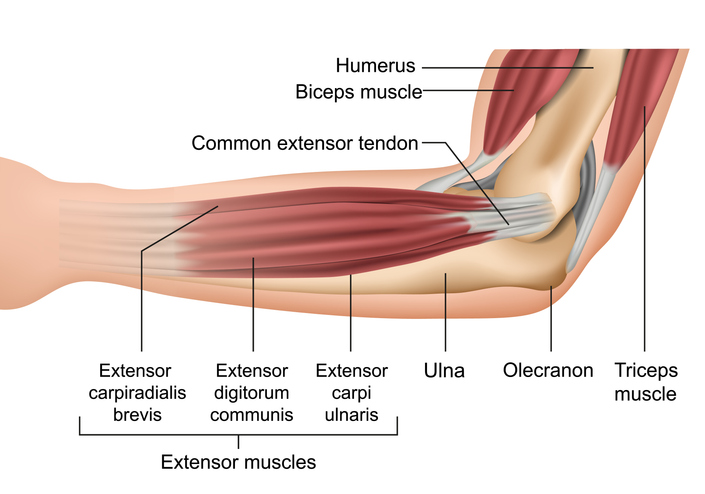Lateral elbow tendinopathy, more commonly known as tennis elbow or lateral epicondylalgia, is an overuse injury affecting the tendons on the outside of the elbow. This condition often arises from placing excessive demand on the tendon, surpassing its capacity. Individuals with lateral elbow pain typically experience pain and stiffness, which can temporarily lessen with gentle movement. The pain associated with lateral elbow pain typically originates from the common extensor tendon and the surrounding tissues The extensor muscles that extend the wrist and fingers are connected to the bone on the outer side of the forearm (the lateral epicondyle) by this the common extensor tendon.

Contrary to what the name implies, tennis elbow isn’t just for tennis players. Sports where athletes grip a stick or a racket, may lead to a higher risk of lateral elbow pain. Similarly, occupations involving a lot of repetitive upper extremity movements, like office or factory work, can also be at risk. Repetitive everyday tasks, such as carrying heavy bags or hammering, can irritate the elbow. Additionally, activities like opening jars, doors, and typing can be challenging for those with tennis elbow.
Tennis Elbow Management
Active self-management is often the key The management of tennis elbow doesn’t differ much from that of other tendon issues. Initial management strategies usually involve reducing tendon load, followed by gradually increasing load tolerance and strength. For individuals with lateral elbow pain, early management is crucial in reducing the risk of persistent symptoms. Therefore, recognizing the early signs, such as pain on the outside of the elbow during activities or at rest, is important. There is a significant difference in management depending on how long the symptoms have been present. In the early stages, the focus should be more on reducing the load and easing the symptoms. If the symptoms have persisted for a couple of months or more, then the main emphasis should be on strengthening the muscles and gradually increasing the load. With perseverance, your symptoms should gradually decrease in intensity over time. This process can take anywhere from a week or two to a month or more, depending on the severity of your tendon pain and its duration.
- Reducing the load (early management) First and foremost, it’s crucial to reduce activities that irritate your tendon. If too much stress continues to be applied to the tissues, the tendon will become increasingly irritated. Therefore, look for ways to modify your everyday tasks, such as opening a jar with your other hand while using a cloth, or carrying your shopping on your forearm or using a backpack. However, also note that excessive rest can actually hinder the healing process in the long run
- Practical tips you can try to ease your symptoms Heat – Place a hot water bottle over your forearm to reduce the feeling of stiffness, especially when the tendon hasn’t been used for a while. It’s best to use a layer of clothing or fabric between the bottle and your skin for safety. Massage – Gentle massage around the tendon to improve circulatory flow can be helpful for some individuals. Start with light pressure, then gradually increase as the tissues warm up. Once warmed, apply more pressure, rubbing across the tendon.
- Topical non-steroidal anti-inflammatory drugs (NSAIDs) can be used alone or in combination with these massage techniques. Elbow Orthoses – Various supports are available for tennis elbow. While some may be suitable for individuals whose symptoms are easily provoked, they should primarily be worn only during activities that trigger symptoms.
- Strengthen and increase the tolerance to load Although in the early stages treating tennis elbow involves managing symptoms and temporarily reducing aggravating activities, it’s also important to understand that, in the long run, strengthening the muscles of the forearm and upper extremity is essential. This strengthening is necessary to handle the load of everyday work and repetitive hand functions. Your Physiotherapist can guide you through the specific exercises suitable for you and your needs.
- If work activities aggravate your pain, consider discussing changes to your workstation setup with your employer. This is particularly important if your job involves repetitive hand movements or the use of force. Physiotherapists, can offer tips on managing the load on your hand during work. In addition, adding small and light movements at regular intervals can often significantly improve your tolerance to the workload.
- Practical tip for exercise therapy Experiencing mild pain during exercise is normal, but it should subside within a few minutes after training. If pain from exercising persists or is worse the next morning, you should take a few days off and then resume with less intensity, either by reducing resistance or doing fewer
- However, if the problem persists for more than 3 months and you find yourself struggling to manage the pain, or if the pain spreads beyond the elbow or you experience numbness in your fingers, it would be wise to consult a Physiotherapist or specialist doctor. The examination will pin point any other areas like the neck which may be contributing to the problem. Further investigations can look at any damage to the tendon. Other treatments can include Platelet rich plasma injections into the tendon or Extracorpeal Shock Wave Therapy which is non invasive and has good results alongside a rehabilitation strength programme.
